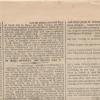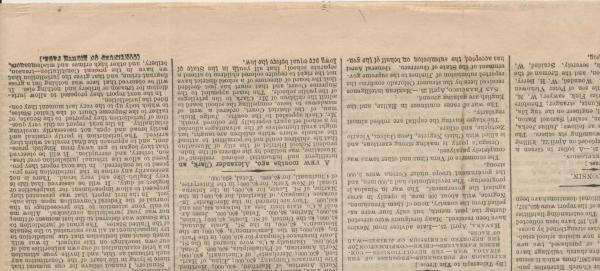Creation of Separate but Equal
| Grade | 3rd Grade | Class | Social Studies | Length of Lesson | 40-45 Minutes |
| Lesson Title | Creation of Separate but Equal |
| Unit Title | Enslavement to the Great Migration |
| Unit Compelling Question | How does oppression force people to stay or move? |
| Historical Context: After the Civil War and the reconstruction era, white supremacy resurfaced across the south and Jim Crow laws began to be put in place. African Americans fled from their homes in the south after harsh segregation laws and unsatisfactory economic opportunities made it impossible for them to flourish. They fled towards the North to take advantage of the need for industrial workers. African Americans wanted to build their own culture in American society. They confronted racial prejudices, as well as political, social, and economic challenges. ~ Allyson Simpson, Simpson College 2018.010.016 This short newspaper article (27 April 1868) discusses a Supreme Court ruling in favor of Alexander Clark over the Independent School District of Muscatine. Prior to this ruling, Clark sued the Muscatine school board on behalf of his daughter, Susan, after he was told she could not attend the same school as white children. The Supreme Court ruled that all children in Iowa were equal before the law, and this landmark case ended school segregation in Iowa. With a job as a barber, Clark was able to meet influential white and black males of Muscatine, helping his voice be heard. He was also a friend of Fredrick Douglass during the 1840s. Muscatine became the largest African-American populated town in the state after many settled there after escaping the South or traveling eastward from other free states. Clark later established the African Methodists Episcopal Church in Muscatine, the first independent black domination in the United States. Clark was a fighter for civil rights and in 1855 signed a petition with state legislature that repealed a law that prohibited free blacks from entering the state. The repeal did not happen, and migration continued. Clark also fought for African-American right to vote and gained the right in 1868. For his children, Clark fought for equal education and sued his daughter's school after she was denied entrance due to her race. Clark won his Supreme Court case and as a result, Iowa became one of the first states to integrate schools. Clark was appointed U.S. Minister to Liberia by President Harrison in 1890, which became one of the highest-ranking appointments of an African-American by a president at that point of time. Clark died while in office of a fever in 1891. |
|
| Lesson Supporting Question | |
| Lesson Overview | Students will embark on an investigation into how the oppression of the African American population in the South motivated them to move up North. Students will take on the roles of a Historian, Geographer, Political Scientist, and Economist to find the different factors that led to the African American moving North. Students will focus on the latter half of the 19th century after the end of the American Civil War. |
| Primary Sources Used |
|
| Resources Needed | |
| Standard | |
| Lesson Target | Students will be able to demonstrate what compels people who are facing oppression to move to a new place and how that changes the demographics of the United States |
| Lesson Themes | |
|
| Formative Assessment (How will you use the formative assessments to monitor and inform instruction?) |
Students will turn in their Historian Research Journals at the end of the less for assessment. To meet the full points students will need to meet the following: |
| Summative Assessment (How does the lesson connect to planned summative assessment(s)?) |
To meet standard SS.3.9, the students will address this standard during the lesson by analyzing primary sources and collaborating with the Historian role. The Historian questions focus on making a note of how African Americans were treated at the end of the 19th-century compare and contrast the treatment of a variety of demographic groups in the past and present. Standard SS.3.8 connected to the lesson through the role of the Political Scientist. This role focuses on answering how the people are treated by different social groups, and what overall happens when the different social groups interact with one another. Standard SS.3.16 is connected through primary source analysis, the debate of separate but equal, and the role of the Economist, and Geographer who research why people take risks to improve their lifestyle and needs. The primary source of the separate and non-segregated schools is motivation for parents to further their own child's education. The source displaying Kansas land for sale, also demonstrates that the promise of land and jobs are big motivators to move. Lastly, standard SS.3.24. Is connected to the lesson by having all students analyzed and explored the intended audience and purpose of the source that they are looking at. Having multiple different source hone in on the student skill to understand the context of the materials and the meaning behind it. |
| Author | Shelby McAllister | Created | Last Edited | ||||
| Reviewer: Dr. Chad Timm, Simpson College | |||||||
| Lesson Plan Development Notes: Social Studies Methods, Simpson College, Spring 2019 | |||||||


